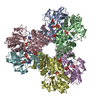+Search query
-Structure paper
| Title | Structural basis of human PRPS2 filaments. |
|---|---|
| Journal, issue, pages | Cell Biosci, Vol. 13, Issue 1, Page 100, Year 2023 |
| Publish date | May 30, 2023 |
 Authors Authors | Guang-Ming Lu / Huan-Huan Hu / Chia-Chun Chang / Jiale Zhong / Xian Zhou / Chen-Jun Guo / Tianyi Zhang / Yi-Lan Li / Boqi Yin / Ji-Long Liu /   |
| PubMed Abstract | BACKGROUND: PRPP synthase (PRPS) transfers the pyrophosphate groups from ATP to ribose-5-phosphate to produce 5-phosphate ribose-1-pyrophosphate (PRPP), a key intermediate in the biosynthesis of ...BACKGROUND: PRPP synthase (PRPS) transfers the pyrophosphate groups from ATP to ribose-5-phosphate to produce 5-phosphate ribose-1-pyrophosphate (PRPP), a key intermediate in the biosynthesis of several metabolites including nucleotides, dinucleotides and some amino acids. There are three PRPS isoforms encoded in human genome. While human PRPS1 (hPRPS1) and human PRPS2 (hPRPS2) are expressed in most tissues, human PRPS3 (hPRPS3) is exclusively expressed in testis. Although hPRPS1 and hPRPS2 share 95% sequence identity, hPRPS2 has been shown to be less sensitive to allosteric inhibition and specifically upregulated in certain cancers in the translational level. Recent studies demonstrate that PRPS can form a subcellular compartment termed the cytoophidium in multiple organisms across prokaryotes and eukaryotes. Forming filaments and cytoophidia is considered as a distinctive mechanism involving the polymerization of the protein. Previously we solved the filament structures of Escherichia coli PRPS (ecPRPS) using cryo-electron microscopy (cryo-EM) . RESULTS: Order to investigate the function and molecular mechanism of hPRPS2 polymerization, here we solve the polymer structure of hPRPS2 at 3.08 Å resolution. hPRPS2 hexamers stack into polymers in the conditions with the allosteric/competitive inhibitor ADP. The binding modes of ADP at the canonical allosteric site and at the catalytic active site are clearly determined. A point mutation disrupting the inter-hexamer interaction prevents hPRPS2 polymerization and results in significantly reduced catalytic activity. CONCLUSION: Findings suggest that the regulation of hPRPS2 polymer is distinct from ecPRPS polymer and provide new insights to the regulation of hPRPS2 with structural basis. |
 External links External links |  Cell Biosci / Cell Biosci /  PubMed:37248548 / PubMed:37248548 /  PubMed Central PubMed Central |
| Methods | EM (single particle) |
| Resolution | 3.08 Å |
| Structure data | EMDB-33883, PDB-7yk1: |
| Chemicals |  ChemComp-PO4:  ChemComp-MG:  ChemComp-ADP: |
| Source |
|
 Keywords Keywords | TRANSFERASE / phosphoribosylpyrophosphate synthetase / complex / filament |
 Movie
Movie Controller
Controller Structure viewers
Structure viewers About Yorodumi Papers
About Yorodumi Papers





 homo sapiens (human)
homo sapiens (human)